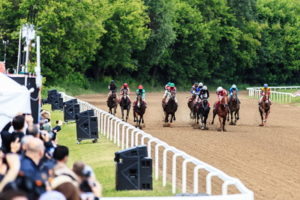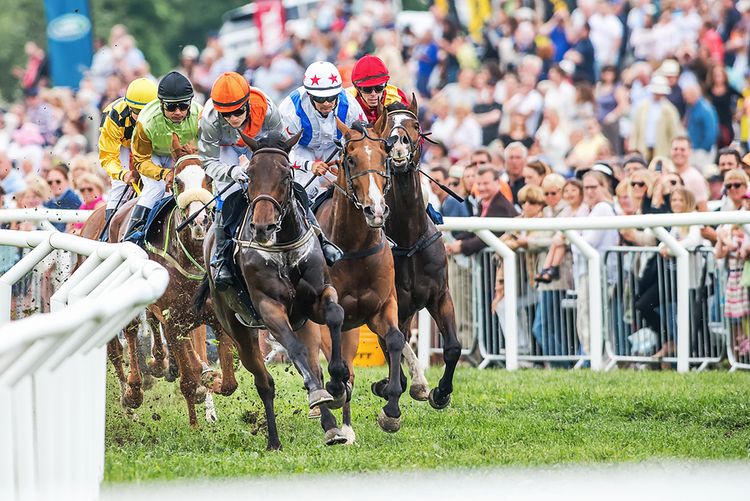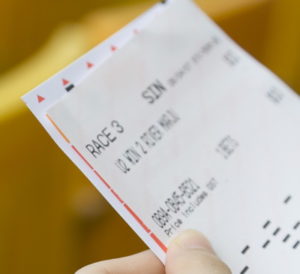 Horse racing represents around a quarter of all bets placed and many people who have a flutter on the racing will place an each-way bet. This is a packaged bet with two separate stakes, one on a horse to win and one on a horse to place. If the horse wins both bets pay out if the horse only places only the place bet pays out, usually at 1/5 or 1/4 the odds.
Horse racing represents around a quarter of all bets placed and many people who have a flutter on the racing will place an each-way bet. This is a packaged bet with two separate stakes, one on a horse to win and one on a horse to place. If the horse wins both bets pay out if the horse only places only the place bet pays out, usually at 1/5 or 1/4 the odds.
That is all very straight forward and it is one reason why it is a popular bet. It is not just horse racing either, you can place each-way bets on pretty much anything that has a finishing order on a multitude of sports. Horse racing is, however, the most popular for an EW bet. Yet what happens in the instance that less horses finish the race than there are places? Can you still pick up a win from this type of bet if this circumstance occurs?
If you can’t, then what does happen with your stake? Is everything lost or does something else take place? Here, we’re going to look at the rules surrounding what happens in this scenario. We’ll find out if the bet is no longer relevant, if you get your money back etc. There must be official rules, after all.
How Does An Each-Way Work?

In most cases, sportsbooks provide several betting markets on horse races. An each-way bet consists of two bets rolled into one, to put it in simpler terms. Those are the ‘win bet’ and the ‘place bet’. Providing an example of this would look as follows:
You place a wager consisting of two stakes of an equal amount in an each-way wager. Both bets are on the same horse. The first bet is on the horse to win the race in question at the odds shown. The second bet is for the horse to place, known as a place bet, this is paid out at a fraction of the odds shown, usually 1/5 or 1/4.
You will win the former bet if your pick crosses the finish line in first position. You win the latter wager if the horse finishes in one of the top positions. The positions included in the bet will depend on how many runners are participating. Often, it will be the top three or four positions. If you wagered £5 each-way on a specific horse, your total bet would be £10.
The standard number of places for horse races are shown below, sometimes bookies increase the number of places for certain bigger races:
- 2-4 runners – no places
- 5-7 runners – 2 places
- 8-15 runners – 3 places
- 16+ runners – 4 places
When you look at an each-way bet market, you’ll need to know three things. The betting odds, the number of places and the each-way fraction.
The betting odds are on display for each of the horses competing. The number of places is usually shown in the top-right. Often, this appears as 1-2-3 or 1-2-3-4. That dictates the number of positions a horse can finish in for your second bet to win. The each-way fraction is also usually displayed in the top-right. As you may guess, the chance of a horse finishing in the top three is bigger than it winning so the odds for the place part of the bet are usually reduced by the fraction provided.
There are three possible outcomes for an each-way bet. The horse can win the race. The horse can place in one of the top positions. The horse doesn’t place at all. Of course, if the horse wins, then it already finishes in a top position. This means that you receive a payout from both your wagers.
If your selected horse does not win but it places, you win part of your each-way wager. Part would settle as a loss, but the place part comes in as a win. Different bookmakers pay out different amounts in this scenario.
What About Fewer Horses Finishing in a Race?
 Let’s say that you opt to gamble on an upcoming horse racing event. The market you choose to bet on has positions 1-2-3 for you to wager on and so a horse would need to finish within the top three for you to win. When you place the bet, there are 10 horses scheduled to run.
Let’s say that you opt to gamble on an upcoming horse racing event. The market you choose to bet on has positions 1-2-3 for you to wager on and so a horse would need to finish within the top three for you to win. When you place the bet, there are 10 horses scheduled to run.
What happens if the number of runners starting the race isn’t the number that finishes, though? Sometimes, horses go astray or fall over while a race is in action.
In this example, 10 may start a race, but only two pass the finish line. Let’s say there’s a scenario where one horse collides into another, and it causes a bit of a pile-up. That takes eight of the runners out of the race due to horses falling over, riders falling off, and so on.
The two remaining runners proceed onwards and cross the finish line in first and second positions. Yet the each-way bet you placed suggests that the top three places provide a payout. With only two remaining in the race after the collision, what happens?
To get an answer regarding this situation, we can look at the official terms and conditions of the Bet365 sportsbook. Its rules on each-way bets for horse racing events state the following:
“In the event of the number of runners in the race being equal to or less than the number of places offered at time of bet placement, then bets will be void”.
At Bet365, if there are fewer horses crossing the finish line or even an equal amount to the number of places (three, in our example), you don’t get a payout for it. That’s even if your chosen horse is one of the runners that does actually cross the finish line and places.
Instead, you will receive your stake back from the bookie. Many bookmakers have the same stance on each-way wagers. It stops you losing out for sure, just in case your horse is one of the runners that falls and is eliminated from the race. At the same time, it also gives the bookmaker the opportunity to cover itself.
Other Things to Consider About Each-Way Bets
 Our example above surrounds 10 runners being involved in a race. We’re turning back to the Bet365 rules once more on each-way wagers for some further information. When races take place, the following are rules to remember for your bets:
Our example above surrounds 10 runners being involved in a race. We’re turning back to the Bet365 rules once more on each-way wagers for some further information. When races take place, the following are rules to remember for your bets:
“Handicaps of 16 or more runners, one quarter the odds, first four places.”
“Handicaps of 12 to 15 runners, one quarter the odds, first three places.”
“All other races of 8 or more runners, one fifth the odds, first three places.”
“Races of 5, 6 or 7 runners, one quarter the odds, first two places.”
“Less than 5 runners, the place money is invested to Win.”
This means that you won’t be able to place an each-way bet on any race that features five or fewer horses competing in it. Instead, you only have the option to place a Win wager, on the one that you believe will cross the finish line in first place.
It also highlights that in all races, the number of runners are those coming under starters orders. Bets are not accepted where the place stake exceeds the stake of the win, either.
Those rules are in place across sportsbooks operating in the United Kingdom in general. This means that wherever you choose to involve yourself in each-way betting, the terms surrounding such will remain the same.
A Real-Life Example of a Potential Bet Not Coming to Fruition
 The rules in place today on each-way betting have not always been this way. In 2011, things were a bit different. A small-field event occurred at Towcester Racecourse in March of that year, beginning at 4.25pm. Only four horses started the novice race, which was to take place across two miles.
The rules in place today on each-way betting have not always been this way. In 2011, things were a bit different. A small-field event occurred at Towcester Racecourse in March of that year, beginning at 4.25pm. Only four horses started the novice race, which was to take place across two miles.
Unfortunately, two of the four horses – Cengiz and Khukov – fell on the same fence during the race. Khukov was the first to fall, tumbling at the sixth fence while out in the lead. Cengiz then went ahead and did the same thing, while trying to swerve out of the way of the already-fallen horse and its jockey.
Two horses remained, with those backing them getting very excited. After all, it was almost a certainty that they could receive at least a payout for an each-way wager. Identity Parade took over as leader, having a four-length gap on Radharc Na Mara. Jockey Adrian Lane believed he had the race in the bag by this time. Unfortunately, Identity Parade was distracted by people near to one of the fences. Instead of leaping over it, the horse came to an almost complete stop before falling after the jump. As a result, Lane was unseated.
Rules introduced in 2009 meant that Lane could not remount Identity Parade and continue with the race. Instead, he and his horse were eliminated from the competition and the race belonged to Peter Toole on the back of Radharc Na Mara.
Unfortunately, with Identity Parade and Lane down on the other side of the fence, Radhac Na Mara stumbled after jumping while trying to avoid a clash. Toole was thus also unseated, meaning that no horse could complete the race. All bets on the event were null and voided, with bookmakers forced to refund the stake money placed on all runners.
Each-way bettors were likely stricken down with a bit of heartbreak at this result. It all seemed to be going in their favour, despite the rules today not being the same on how many horses have to compete before an each-way bet is possible. One or two other instances have occurred in the past featuring horses not finishing races, such as a Plumpton in 1911 and in the Czech Republic in 1909 – suffice to say it is a very rare occurrence indeed.
